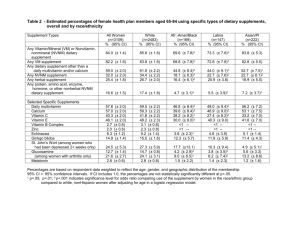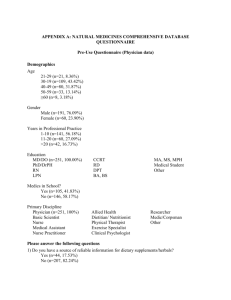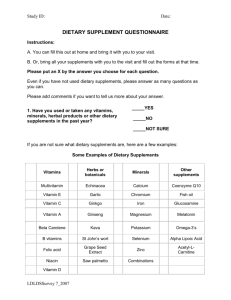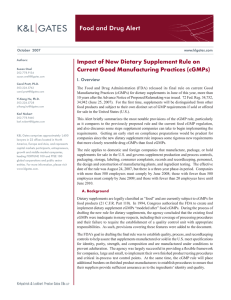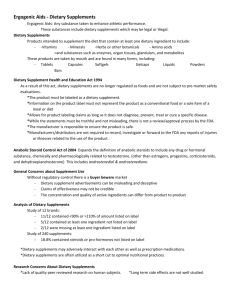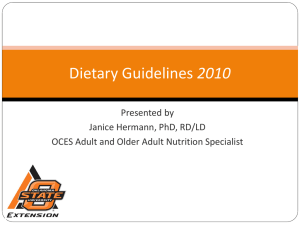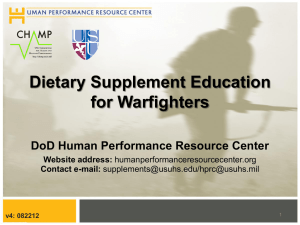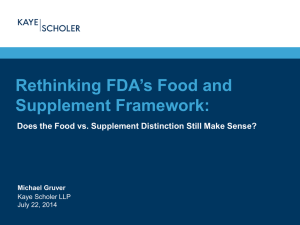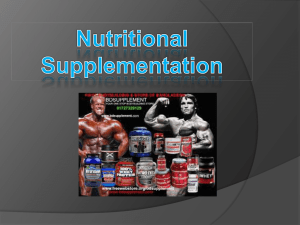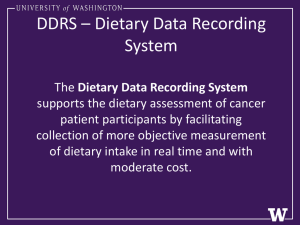Slides - Food and Drug Law Institute
advertisement
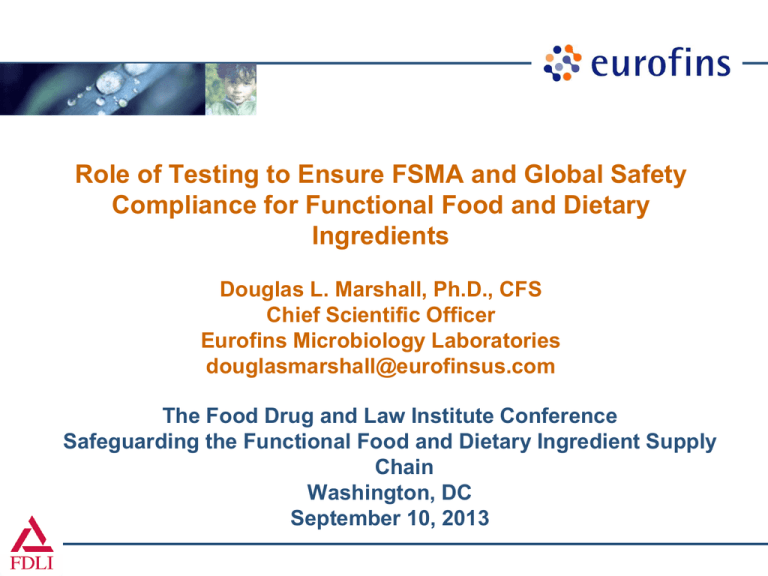
Role of Testing to Ensure FSMA and Global Safety Compliance for Functional Food and Dietary Ingredients Douglas L. Marshall, Ph.D., CFS Chief Scientific Officer Eurofins Microbiology Laboratories douglasmarshall@eurofinsus.com The Food Drug and Law Institute Conference Safeguarding the Functional Food and Dietary Ingredient Supply Chain Washington, DC September 10, 2013 Eurofins’ Mission is Health and Safety Food #1 worldwide Environment #1 worldwide Our Mission: Pharmaceuticals #1 or 2 worldwide To contribute to global health and safety by providing our customers with high-quality laboratory and advisory services while creating opportunities for our employees and generating sustainable shareholder value 2 Growing Network of World-Class Laboratories Worldwide >180 laboratories in 35 countries U.S. Laboratory Competence Centers metals supplements dairy, microbiology seed nutritional, microbiology, auditing grain mid- and near IR microbiology Microbiology, filth/extraneous seed chemical contaminants, GMO, allergens microbiology Disclaimer • I do not work for or represent FDA or the Federal Government • I have no current or previous relationship with FDA • The opinions expressed here are based on an analysis of publically available information • I have a potential conflict of interest as an employee of Eurofins, which provides food and supplement analytical, auditing, and consulting services 4 Old School Pillars of Food Safety • Current Good Manufacturing Practices (CGMPs) • Sanitation Standard Operating Procedures (SSOPs) • Hazard Analysis Critical Control Point Program (HACCP) 5 New School Pillars of Food Safety • Environmental Monitoring Program (EMP) – pathogens & allergens • Supplier Verification Programs – don’t inherit your suppliers problems • Audits – naivety in use 6 CGMP/Hazard Analysis/Preventative Control Proposed Rule • 21 CFR part 110 Current Good Manufacturing Practices are updated • 21 CFR part 117 updates to mandate formal identification and analysis of food safety hazards reasonably likely to occur during processing, packaging, and holding of food • Implement risk-based preventative controls to minimize or prevent hazards reasonably likely to occur • Details required elements of a written food safety plan • Mandates a “qualified individual” to develop and manage food safety plan – formally trained or on-job experience 7 FSMA CGMPs • Manufacturing processes are clearly defined and controlled • Changes in manufacturing processes are carefully evaluated • • • • • • • Written operational procedures Trained employees Adequate record keeping Batch history Product quality maintained during distribution Recall plan Recurrence prevention plan 8 Required Food Safety Plan Elements Hazard Analysis Preventive Controls Reanalysis Validation Records Verification Monitoring Corrective Actions 9 Which Contaminants are Important to Me? Contaminants potentially can be found in ANY food, supplement, or ingredient at ANY time! Preventive Control Programs • Training programs for managers and/or workers • Written records, e.g., batch records, sanitation records, critical control point records • • • • Validation of control measures Written sanitation SOPs Food label review and control program Testing of in-coming raw materials, in-process materials, finished products, and processing environment 11 Required Preventive Controls • • • • Process Controls Food Allergen Controls Sanitation Controls Recall Plan • Supplier Approval and Verification Program – not required in proposed rule, but FDA believes this is an important element and is seeking comments 12 Allergen Control Program • Training of processing and supervisory personnel • Segregation of food allergens during storage & handling • Validated cleaning procedures for food contact equipment • Prevention of cross contact during processing through measures such as: Scheduling of production runs Control or rework Use of dedicated production lines • Product label review and label usage and control • Supplier control program for ingredients and labels 13 Know What You’re Doing Validation • Science-based evidence used to support decision making Verification • Are you doing what you say you should do? • Are your suppliers providing you with what you desire? 14 Required Verification Activities • Prove that preventive controls are implemented and working effectively • Validate the adequacy of preventive controls for their purpose and effectiveness in controlling the hazard • Verify that controls are operating as intended and review of monitoring records • Requires reassessment of the food safety plan at least every three years and at other times as needed 15 Suggested Verification Activities • Product and environmental testing programs are not required in proposed rule but FDA believes these are important science-based verification activities • Review of customer and other complaints 16 Required Recordkeeping • • • • • Written food safety plan, including the hazard analysis Preventive controls Monitoring Corrective actions Verification 17 Records • Employee training programs related to food safety and GMPs. Such records should include a description of the training program(s) and evidence of successful completion of the training for each affected employee • Allergen control plans and records documenting compliance with the provisions of that plan • Listeria monocytogenes control plans and records documenting compliance with the provisions of that plan • Written sanitation procedures • HACCP plan documents and records demonstrating process control of CCPs 18 Additional Suggested Activities • Required training for employees and supervisors, including a requirement for records that document training • Require, rather than recommend, cleaning non-foodcontact surfaces of equipment as frequently as necessary to protect against contamination of food and food-contact surfaces 19 Motivation for Supplement CGMPs • Dietary supplements that contain ingredients in amounts that are greater than those listed on the label • Dietary supplements that contain ingredients in amounts that are less than those listed on the label • Wrong ingredient • Presence of contaminants (e.g., bacteria, pesticides, glass, lead, foreign material) • improper packaging • Mislabeling 20 Supplement CGMPs • Design and construction of physical plants that facilitate maintenance • • • • Cleaning Proper manufacturing operations Quality control procedures Testing final product or incoming and inprocess materials • Handling consumer complaints • Maintain records 21 Supplement CGMPs • Employ qualified employees and supervisors • Design and construct their physical plant in a manner to protect dietary ingredients and dietary supplements from becoming adulterated during manufacturing, packaging, labeling and holding • Use equipment and utensils that are of appropriate design, construction, and workmanship for the intended use • Establish and use master manufacturing and batch production records • Establish procedures for quality control operations 22 Supplement CGMPs • Hold and distribute dietary supplements and materials used to manufacture dietary supplements under appropriate conditions of temperature, humidity, light, and sanitation so that the quality of the dietary supplement is not affected • Keep a written record of each product complaint related to CGMPs • Retain records for 1 year past the shelf life date, if shelf life dating is used, or 2 years beyond the date of distribution of the last batch of dietary supplements associated with those records 23 Role of Testing Monitor Ingredient and Finished Product Specifications • • • • Identity Purity Strength Composition Monitor Products and Process Environment for Contaminants • Pathogens • Heavy Metals • Pesticides 24 Why Test? • • • • • • Brand protection Liability reduction Regulatory expectation Validate effectiveness of control plans Validate purchase specifications by our your customer Outbreak investigations 25 FSMA New Testing Requirements • All affected food must be evaluated for safety – final product and environmental testing • Monitoring requirements must verify that controls are working correctly 26 Additional Motivation Liability Insurers Auditors Investigators Manufacturers Competitors Lawyers Customers 27 Cost of Not Testing • • • • • Potential for injuring or killing your customer Intrinsic and extrinsic costs associated with recalls Damaged brand reputation Loss of customer confidence in your products No liability protection 28 Key Points on Testing • If a sample tests positive for a pathogen or harmful chemical, the entire lot/batch is considered positive • Subsequent negatives do not negate a positive result • Have in advance a plan of action in the event of a positive result • Refuse • Divert – no direct human contact and no pathogenic strains • Destroy • Recondition 29 30 Thank you for the opportunity to provide this overview We look forward to working with you in the future www.eurofinsus.com
